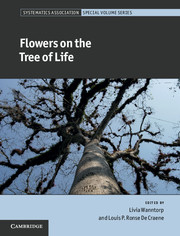Book contents
- Frontmatter
- Contents
- Contributors
- Acknowledgements
- 1 Introduction: Establishing the state of the art – the role of morphology in plant systematics
- 2 Spatial separation and developmental divergence of male and female reproductive units in gymnosperms, and their relevance to the origin of the angiosperm flower
- 3 New flowers of Laurales from the Early Cretaceous (Early to Middle Albian) of eastern North America
- 4 Tracing the early evolutionary diversification of the angiosperm flower
- 5 Changing views of flower evolution and new questions
- 6 Centrifugal stamens in a modern phylogenetic context: was Corner right?
- 7 Evolution of the palm androecium as revealed by character mapping on a supertree
- 8 Comparative floral structure and development of Nitrariaceae (Sapindales) and systematic implications
- 9 Multiplications of floral organs in flowers: a case study in Conostegia (Melastomataceae, Myrtales)
- 10 Ontogenetic and phylogenetic diversification in Marantaceae
- 11 Floral ontogeny of Acacia celastrifolia: an enigmatic mimosoid legume with pronounced polyandry and multiple carpels
- 12 Floral development of Napoleonaea (Lecythidaceae), a deceptively complex flower
- Taxon index
- Subject index
- Plate section
3 - New flowers of Laurales from the Early Cretaceous (Early to Middle Albian) of eastern North America
Published online by Cambridge University Press: 07 October 2011
- Frontmatter
- Contents
- Contributors
- Acknowledgements
- 1 Introduction: Establishing the state of the art – the role of morphology in plant systematics
- 2 Spatial separation and developmental divergence of male and female reproductive units in gymnosperms, and their relevance to the origin of the angiosperm flower
- 3 New flowers of Laurales from the Early Cretaceous (Early to Middle Albian) of eastern North America
- 4 Tracing the early evolutionary diversification of the angiosperm flower
- 5 Changing views of flower evolution and new questions
- 6 Centrifugal stamens in a modern phylogenetic context: was Corner right?
- 7 Evolution of the palm androecium as revealed by character mapping on a supertree
- 8 Comparative floral structure and development of Nitrariaceae (Sapindales) and systematic implications
- 9 Multiplications of floral organs in flowers: a case study in Conostegia (Melastomataceae, Myrtales)
- 10 Ontogenetic and phylogenetic diversification in Marantaceae
- 11 Floral ontogeny of Acacia celastrifolia: an enigmatic mimosoid legume with pronounced polyandry and multiple carpels
- 12 Floral development of Napoleonaea (Lecythidaceae), a deceptively complex flower
- Taxon index
- Subject index
- Plate section
Summary
Introduction
The increasing number of fossil angiosperm reproductive structures described from Cretaceous strata (e.g. Friis et al., 2006) has provided a wealth of new data for understanding aspects of early flowering-plant evolution. In particular, flowers retrieved from many newly discovered mesofossil floras are often three-dimensionally preserved, which permits detailed morphological and systematic analyses. They have thereby provided information on the phylogenetic diversity and reproductive biology of Cretaceous angiosperms (e.g. Friis et al., 2006, 2010). However, an important feature of the angiosperm fossil record from the Cretaceous is that many fossils, particularly from the Early Cretaceous, cannot readily be accommodated in living taxa at the family or genus level, either because they are too poorly preserved to show the diagnostic features needed for secure systematic placement, or because they show a mosaic of features found in several living groups, indicating that they represent extinct lineages on internal branches of the angiosperm phylogenetic tree. The focus of this paper is on two early fossils of the second kind. While their relationships to extant Laurales are secure, they show features indicating that they fall outside the circumscription of extant families in the order.
Studies of relationships among living angiosperms based on analyses of DNA sequences support the recognition of the Laurales as a monophyletic group of seven extant families (Calycanthaceae, Siparunaceae, Gomortegaceae, Atherospermataceae, Hernandiaceae, Monimiaceae, Lauraceae; Renner, 1999, 2005; Renner and Chanderbali, 2000). The Laurales are the sister group to Magnoliales and include between 2840 and 3340 species in about 92 genera (Renner, 2005). The Calycanthaceae are the well-supported sister group to the remainder of the order, the core Laurales (Fig 3.1), within which Atherospermataceae, Gomortegaceae and Siparunaceae also form a well-supported clade (e.g. Renner, 1999, 2005). Relationships among Lauraceae, Monimiaceae and Hernandiaceae are currently not settled securely (Renner and Chanderbali, 2000). Morphological data strongly support a sister relationship of Hernandiaceae and Lauraceae (e.g. Doyle and Endress, 2000; Endress and Doyle, 2009), as do some molecular analyses (e.g. Qiu et al., 1999, 2006). However, in other molecular analyses the pattern of relationships among these three families is not well resolved (e.g. Renner, 1999, 2005; Chanderbali et al., 2001; Soltis et al., 2007).
- Type
- Chapter
- Information
- Flowers on the Tree of Life , pp. 49 - 87Publisher: Cambridge University PressPrint publication year: 2011
- 9
- Cited by

